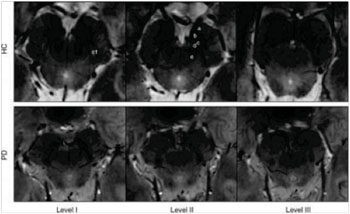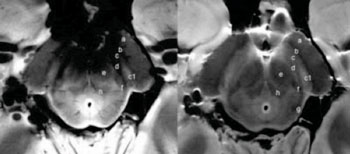Ultrahigh-Field MRI Shows Potential for Earlier Diagnosis of Parkinson’s Disease
|
By MedImaging International staff writers Posted on 20 Mar 2014 |

Top row: 7-Tesla 3D multiecho susceptibility-weighted in vivo images of SN in healthy 64-year-old man, located between the crus cerebri (a) and the red nucleus. Axial sections perpendicular to the floor of fourth ventricle are obtained at level of the inferior third of the red nucleus (level I), at the level of decussation of superior cerebellar peduncles (e) (level II), and at the level of the inferior colliculi (level III). At level I, substantia nigra (SN) appears as homogeneous hypointense structure in the medial part of the cerebral peduncle, and is laterally constituted by a hyperintense oval area between two hypointense layers (c1). At level II, a trilaminar organization of the SN with a central hyperintense layer (b) between two hypointense tiers (c and d) is detectable. At level III, the dorsal hypointense lamina could be detected as a small residual lateral hypointense area, while the hyperintense layer fades into the isointense cerebral peduncle. Bottom row: 7-T three-dimensional multiecho susceptibility-weighted in vivo images of the SN in PD patients. The loss of normal anatomy of the SN in a 61-year-old man with PD is characterized by the disappearance of the oval-shape bright spot in the lateral part of the SN at level I and by the loss of the hyperintense intermediate layer of the SN at level II. HC = healthy subject (Photo courtesy of the Radiological Society of North America).

Image: axial spin-echo proton density (on the right) and GRE (on the left) of the substantia nigra (SN) at level I of an ex vivo brain sample in a 67-year-old woman. There is a triple-layered organization of the SN comparable to that showed in the in vivo images. Ventrally a low-signal-intensity layer (b) is attributable to the pars reticulata of the SN. In the middle part of the SN, a hyperintense band (c) corresponds to the ventral component of the pars compacta of the SN. The lateral part of this layer shows a high-signal intensity spot (c1) corresponding to the oval shape hyperintensity of the in vivo 3D multiecho susceptibility-weighted images that resemble the nigrosome formation. The dorsal hypointense layer visible on both spin-echo and GRE images (d) is referred to the dorsal component of the pars compacta of the SN. a = crus cerebri, e = brachjum conjunctivum, f = medial lemniscus, g = lateral lemniscus, h = central tegmental tract (Photo courtesy of the Radiological Society of North America).
New research has revealed that ultrahigh-field magnetic resonance imaging (MRI) provides detailed views of a brain area implicated in Parkinson’s disease (PD); possibly leading to earlier detection of a disorder that affects millions worldwide.
The study’s findings are published online March 2014 in the journal Radiology. Parkinson’s disease is a chronic, progressive disease characterized by stiffness, shaking, and impaired balance and coordination. With no imaging modalities available to help in diagnosis, clinicians have had to depend on medical history and neurologic exam. It is frequently problematic to distinguish PD from other disorders using these techniques alone.
Mirco Cosottini, MD, from the University of Pisa (Italy), and colleagues examined the brains of 38 individuals, including 17 PD patients and 21 healthy control subjects, as well as a brain sample from a deceased individual, to help determine the effectiveness of ultra-high-field 7-Tesla MRI for identifying PD.
The investigators, utilizing the 7-Tesla MRI scanning, were able to differentiate a three-layered organization of the substantia nigra (SN), a crescent-shaped mass of cells in the midbrain. PD results from the loss of dopamine-producing cells located in this region of the brain. Dopamine is an important neurotransmitter involved in a number of brain functions, including motor and behavioral processes such as addiction, mood, reward, and stress.
Based on abnormalities in the SN identified by the 7-Tesla MRI scanning, the researchers accurately categorized patients with PD with a sensitivity of 100% and specificity of 96.2%.
According to Dr. Cosottini, the findings show potential for earlier detection of the disease, which could speed the initiation of treatment. “Parkinson’s disease diagnosis remains clinically based, but with the introduction of 7-Tesla MRI into clinical practice, a supporting radiologic diagnosis can be made,” he said.
The researchers also are investigating the clinical usefulness of 7-Tesla MRI in several other neurodegenerative disorders, including mild cognitive impairment, a precursor of Alzheimer’s disease.
Related Links:
University of Pisa
The study’s findings are published online March 2014 in the journal Radiology. Parkinson’s disease is a chronic, progressive disease characterized by stiffness, shaking, and impaired balance and coordination. With no imaging modalities available to help in diagnosis, clinicians have had to depend on medical history and neurologic exam. It is frequently problematic to distinguish PD from other disorders using these techniques alone.
Mirco Cosottini, MD, from the University of Pisa (Italy), and colleagues examined the brains of 38 individuals, including 17 PD patients and 21 healthy control subjects, as well as a brain sample from a deceased individual, to help determine the effectiveness of ultra-high-field 7-Tesla MRI for identifying PD.
The investigators, utilizing the 7-Tesla MRI scanning, were able to differentiate a three-layered organization of the substantia nigra (SN), a crescent-shaped mass of cells in the midbrain. PD results from the loss of dopamine-producing cells located in this region of the brain. Dopamine is an important neurotransmitter involved in a number of brain functions, including motor and behavioral processes such as addiction, mood, reward, and stress.
Based on abnormalities in the SN identified by the 7-Tesla MRI scanning, the researchers accurately categorized patients with PD with a sensitivity of 100% and specificity of 96.2%.
According to Dr. Cosottini, the findings show potential for earlier detection of the disease, which could speed the initiation of treatment. “Parkinson’s disease diagnosis remains clinically based, but with the introduction of 7-Tesla MRI into clinical practice, a supporting radiologic diagnosis can be made,” he said.
The researchers also are investigating the clinical usefulness of 7-Tesla MRI in several other neurodegenerative disorders, including mild cognitive impairment, a precursor of Alzheimer’s disease.
Related Links:
University of Pisa
Latest MRI News
- Low-Cost Whole-Body MRI Device Combined with AI Generates High-Quality Results
- World's First Whole-Body Ultra-High Field MRI Officially Comes To Market
- World's First Sensor Detects Errors in MRI Scans Using Laser Light and Gas
- Diamond Dust Could Offer New Contrast Agent Option for Future MRI Scans
- Combining MRI with PSA Testing Improves Clinical Outcomes for Prostate Cancer Patients
- PET/MRI Improves Diagnostic Accuracy for Prostate Cancer Patients
- Next Generation MR-Guided Focused Ultrasound Ushers In Future of Incisionless Neurosurgery
- Two-Part MRI Scan Detects Prostate Cancer More Quickly without Compromising Diagnostic Quality
- World’s Most Powerful MRI Machine Images Living Brain with Unrivaled Clarity
- New Whole-Body Imaging Technology Makes It Possible to View Inflammation on MRI Scan
- Combining Prostate MRI with Blood Test Can Avoid Unnecessary Prostate Biopsies
- New Treatment Combines MRI and Ultrasound to Control Prostate Cancer without Serious Side Effects
- MRI Improves Diagnosis and Treatment of Prostate Cancer
- Combined PET-MRI Scan Improves Treatment for Early Breast Cancer Patients
- 4D MRI Could Improve Clinical Assessment of Heart Blood Flow Abnormalities
- MRI-Guided Focused Ultrasound Therapy Shows Promise in Treating Prostate Cancer
Channels
Radiography
view channel
Novel Breast Imaging System Proves As Effective As Mammography
Breast cancer remains the most frequently diagnosed cancer among women. It is projected that one in eight women will be diagnosed with breast cancer during her lifetime, and one in 42 women who turn 50... Read more
AI Assistance Improves Breast-Cancer Screening by Reducing False Positives
Radiologists typically detect one case of cancer for every 200 mammograms reviewed. However, these evaluations often result in false positives, leading to unnecessary patient recalls for additional testing,... Read moreUltrasound
view channel.jpg)
Diagnostic System Automatically Analyzes TTE Images to Identify Congenital Heart Disease
Congenital heart disease (CHD) is one of the most prevalent congenital anomalies worldwide, presenting substantial health and financial challenges for affected patients. Early detection and treatment of... Read more
Super-Resolution Imaging Technique Could Improve Evaluation of Cardiac Conditions
The heart depends on efficient blood circulation to pump blood throughout the body, delivering oxygen to tissues and removing carbon dioxide and waste. Yet, when heart vessels are damaged, it can disrupt... Read more
First AI-Powered POC Ultrasound Diagnostic Solution Helps Prioritize Cases Based On Severity
Ultrasound scans are essential for identifying and diagnosing various medical conditions, but often, patients must wait weeks or months for results due to a shortage of qualified medical professionals... Read moreNuclear Medicine
view channelNew PET Agent Rapidly and Accurately Visualizes Lesions in Clear Cell Renal Cell Carcinoma Patients
Clear cell renal cell cancer (ccRCC) represents 70-80% of renal cell carcinoma cases. While localized disease can be effectively treated with surgery and ablative therapies, one-third of patients either... Read more
New Imaging Technique Monitors Inflammation Disorders without Radiation Exposure
Imaging inflammation using traditional radiological techniques presents significant challenges, including radiation exposure, poor image quality, high costs, and invasive procedures. Now, new contrast... Read more
New SPECT/CT Technique Could Change Imaging Practices and Increase Patient Access
The development of lead-212 (212Pb)-PSMA–based targeted alpha therapy (TAT) is garnering significant interest in treating patients with metastatic castration-resistant prostate cancer. The imaging of 212Pb,... Read moreGeneral/Advanced Imaging
view channelBone Density Test Uses Existing CT Images to Predict Fractures
Osteoporotic fractures are not only devastating and deadly, especially hip fractures, but also impose significant costs. They rank among the top chronic diseases in terms of disability-adjusted life years... Read more
AI Predicts Cardiac Risk and Mortality from Routine Chest CT Scans
Heart disease remains the leading cause of death and is largely preventable, yet many individuals are unaware of their risk until it becomes severe. Early detection through screening can reveal heart issues,... Read moreImaging IT
view channel
New Google Cloud Medical Imaging Suite Makes Imaging Healthcare Data More Accessible
Medical imaging is a critical tool used to diagnose patients, and there are billions of medical images scanned globally each year. Imaging data accounts for about 90% of all healthcare data1 and, until... Read more
Global AI in Medical Diagnostics Market to Be Driven by Demand for Image Recognition in Radiology
The global artificial intelligence (AI) in medical diagnostics market is expanding with early disease detection being one of its key applications and image recognition becoming a compelling consumer proposition... Read moreIndustry News
view channel
Hologic Acquires UK-Based Breast Surgical Guidance Company Endomagnetics Ltd.
Hologic, Inc. (Marlborough, MA, USA) has entered into a definitive agreement to acquire Endomagnetics Ltd. (Cambridge, UK), a privately held developer of breast cancer surgery technologies, for approximately... Read more
Bayer and Google Partner on New AI Product for Radiologists
Medical imaging data comprises around 90% of all healthcare data, and it is a highly complex and rich clinical data modality and serves as a vital tool for diagnosing patients. Each year, billions of medical... Read more



















